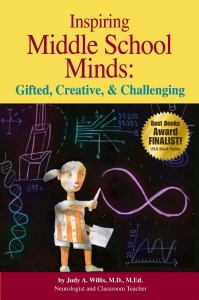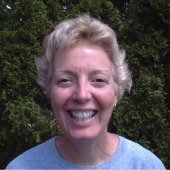Inspiring the Adolescent Brain
Inspiring Middle School Minds: Gifted, Creative & Challenging
by Judy A. Willis, M.D., M.Ed.
(Great Potential Press, 2009 – Learn more)
Inspiring Middle School Minds: Gifted, Creative & Challenging, is not only about brain development in 10-14 year olds, it inspired me to think differently about the way I teach lessons to my middle grades students! Don’t be fooled by “Gifted” in the title! It’s a book about brain development in ALL students at middle school. The author, Dr. Judy Willis, explores the anatomy of the brain and how to use brain research to design effective lessons in the middle school classroom. It was a fascinating read!
Sometimes starting at the end of a book helps me understand the beginning and that’s what I did. This book comes loaded with information in the appendices. It starts with enrichment and extension activities for specific content areas as well as interdisciplinary units. Next comes a glossary of terms (terms related to the anatomy of the brain) that I needed to refer to often as I was reading. I was thankful it was included. After the glossary there are copious endnotes for each chapter that not only provide the research authors’ names, but also include websites and explanations. The last section of the appendix is reserved for references, a comprehensive bibliography for those readers interested in following up on brain research.

From brain research to practical lessons
Throughout each chapter, I found it thought-provoking when Dr. Willis intertwined the brain research with practical classroom lessons that utilized the brainpower of 10 to 14-year olds in the classroom.
For example, she highlighted the Iditarod as a topic for an interdisciplinary unit and suggested quite a few lessons using brain research to enhance students’ learning at this level. As it happens, I use this topic too when teaching Call of the Wild to my 7th and 8th graders. It was insightful to compare her ideas with mine.
I was a bit intimidated by the plethora of scientific vocabulary and densely packed text. However, Dr. Willis has an easy-to-understand writing style that took the science and positioned it in familiar territory for me: a middle school classroom with adolescents. Even though the book was written in 2009 and its NCLB references seem somewhat dated, the content about adolescent brain development, how to apply it in the classroom, and how to create engaging brain-friendly lessons, is timeless.
No dumbing down!
There is a recurring message and reminder from Dr. Willis throughout the book — avoid teaching to the test! Eliminate the “dumbing down” of lessons into skill and drill worksheets used for test purposes only. Teach lessons that engage the adolescent brain with inquiry, questioning, and timely, constructive feedback.
I have often wondered how to avoid having my students stare at the clock. And I have tried several strategies to do just that. Some of these work, but Dr. Willis makes her point that teachers need to construct challenging lessons that focus on the interests of our students, give students choices, make information relevant, and stimulate curiosity.
Inspiring Middle School Minds: Gifted, Creative & Challenging made me rethink my lessons for the upcoming year with my 6th graders. I won’t be teaching gifted, but I will be thinking about the brain research as I construct engaging, challenging lessons for my students, who will also benefit from brain-savvy lessons.
Diane Horban has taught regular and gifted Language Arts for 33 years in grades 3 through 8, with most of her experience in middle school. She is currently teaching 6th grade R/LA in District 34, Glenview, IL. During her teaching tenure, Diane has published two articles in the ISTE journal Learning and Leading with Technology, held the position of instructional specialist, and mentored several teachers. She is currently working on a district committee supporting implementation of Common Core standards. Please email her with questions at dhorban@glenview34.org.



































